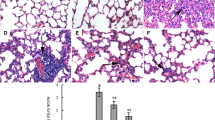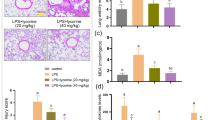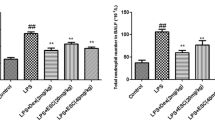Abstract
This study investigated the protective effect and underlying mechanism of action of umbelliferone (Umb) against lipopolysaccharide (LPS)-induced acute lung injury (ALI). An intragastric Umb injection prior to the administration of LPS dramatically decreased the wet/dry lung weight ratio, attenuated inflammatory cell infiltration in lung tissue, and reduced the LPS-induced production of inflammatory cytokines, including monocyte chemotactic protein-1(MCP-1), interleukin (IL)-6, tumor necrosis factor-α (TNF-α), and IL-1β, in broncheoalveolar lavage fluid (BALF). In addition, Umb resulted in significant anti-oxidative effects as shown by decreased myeloperoxidase (MPO) and malondialdehyde (MDA) activity and increased superoxide dismutase (SOD) activity compared with the LPS group. Finally, the inhibitory effects of Umb on the expression of toll-like receptor 4 (TLR4)/myeloid differentiation protein 88 (MyD88)/nuclear factor-κB (NF-κB) signaling pathway proteins were also measured. Our results clearly indicated that Umb exerted significant protective effects on LPS-induced ALI by inhibiting the activation of the TLR4/MyD88/NF-κB pathway.






Similar content being viewed by others
References
Atabai, K., and M.A. Matthay. 2002. The pulmonary physician in critical care. 5: Acute lung injury and the acute respiratory distress syndrome: definitions and epidemiology. Thorax 57 (5): 452–458. https://doi.org/10.1136/thorax.57.5.452.
Baker, R.G., M.S. Hayden, and S. Ghosh. 2011. NF-kappa B, Inflammation, and Metabolic Disease. Cell Metabolism 13 (1): 11–22. https://doi.org/10.1016/j.cmet.2010.12.008.
Banerji, N., M. Maiti, S. Sem, and P.C. Datta. 1982. Pharmacognosy of Aegle marmelos (L) Correa. seed. A new protein source. Acta Pharm Hung 52 (3): 97–101.
Barton, G.M., and R. Medzhitov. 2003. Toll-like receptor signaling pathways. Science 300 (5625): 1524–1525. https://doi.org/10.1126/science.1085536.
Bouchama, A., and J.P. Knochel. 2002. Heat stroke. The New England Journal of Medicine 346 (25): 1978–1988. https://doi.org/10.1056/NEJMra011089.
Cai, Z., J. Liu, H. Bian, J. Cai, and G. Zhu. 2016. Suppression of P2X7/NF-kappaB pathways by Schisandrin B contributes to attenuation of lipopolysaccharide-induced inflammatory responses in acute lung injury. Archives of Pharmacal Research 39 (4): 499–507. https://doi.org/10.1007/s12272-016-0713-0.
Chu, L.L., R.P. Pandey, H.N. Lim, H.J. Jung, N.H. Thuan, T.S. Kim, and J.K. Sohng. 2017. Synthesis of umbelliferone derivatives in Escherichia coli and their biological activities. Journal of Biological Engineering 11: 15. https://doi.org/10.1186/s13036-017-0056-5.
Doyle, S.L., and L.A. O'Neill. 2006. Toll-like receptors: From the discovery of NFkappaB to new insights into transcriptional regulations in innate immunity. Biochemical Pharmacology 72 (9): 1102–1113. https://doi.org/10.1016/j.bcp.2006.07.010.
Goodman, R.B., J. Pugin, J.S. Lee, and M.A. Matthay. 2003. Cytokine-mediated inflammation in acute lung injury. Cytokine & Growth Factor Reviews 14 (6): 523–535. https://doi.org/10.1016/S1359-6101(03)00059-5.
Grommes, J., and O. Soehnlein. 2011. Contribution of neutrophils to acute lung injury. Molecular Medicine 17 (3–4): 293–307. https://doi.org/10.2119/molmed.2010.00138.
Haig, T.J., T.J. Haig, A.N. Seal, J.E. Pratley, M. An, and H.W. Wu. 2009. Lavender as a source of novel plant compounds for the development of a natural herbicide. Journal of Chemical Ecology 35 (9): 1129–1136. https://doi.org/10.1007/s10886-009-9689-2.
Hoult, J.R., and M. Paya. 1996. Pharmacological and biochemical actions of simple coumarins: Natural products with therapeutic potential. General Pharmacology 27 (4): 713–722.
Jeyaseelan, S., H.W. Chu, S.K. Young, and G.S. Worthen. 2004. Transcriptional profiling of lipopolysaccharide-induced acute lung injury. Infection and Immunity 72 (12): 7247–7256. https://doi.org/10.1128/Iai.72.12.7247-7256.2004.
Jiang, W., F. Luo, Q. Lu, J. Liu, P. Li, X. Wang, Y. Fu, K. Hao, T. Yan, and X. Ding. 2016. The protective effect of Trillin LPS-induced acute lung injury by the regulations of inflammation and oxidative state. Chemico-Biological Interactions 243: 127–134. https://doi.org/10.1016/j.cbi.2015.09.010.
Jobin, C., C.A. Bradham, M.P. Russo, B. Juma, A.S. Narula, D.A. Brenner, and R.B. Sartor. 1999. Curcumin blocks cytokine-mediated NF-kappa B activation and proinflammatory gene expression by inhibiting inhibitory factor I-kappa B kinase activity. Journal of Immunology 163 (6): 3474–3483.
Kanimozhi, G., N.R. Prasad, S. Ramachandran, and K.V. Pugalendi. 2011. Umbelliferone modulates gamma-radiation induced reactive oxygen species generation and subsequent oxidative damage in human blood lymphocytes. European Journal of Pharmacology 672 (1–3): 20–29. https://doi.org/10.1016/j.ejphar.2011.09.003.
Kim, T.W., E.H. Joh, B. Kim, and D.H. Kim. 2012. Ginsenoside Rg5 ameliorates lung inflammation in mice by inhibiting the binding of LPS to toll-like receptor-4 on macrophages. International Immunopharmacology 12 (1): 110–116. https://doi.org/10.1016/j.intimp.2011.10.023.
Kofinas, C., L. Chinou, A. Loukis, C. Harvala, C. Roussakis, M. Maillard, and K. Hostettmann. 1998. Cytotoxic coumarins from the aerial parts of Tordylium apulum and their effects on a non-small-cell bronchial carcinoma cell line. Planta Medica 64 (2): 174–176. https://doi.org/10.1055/s-2006-957398.
Kwak, S.H., H.B. Bae, S.J. Kim, M. Li, and C.W. Jeong. 2010. Effect of curcumin on LPS-induced neutrophil activation and acute lung injury. European Journal Of Anaesthesiology 27 (1): 187–187. https://doi.org/10.1097/00003643-201006121-00598.
Lang, J.D., P.J. McArdle, P.J. O'Reilly, and S. Matalon. 2002. Oxidant-antioxidant balance in acute lung injury. Chest 122 (6): 314s–320s. https://doi.org/10.1378/chest.122.6_suppl.314S.
Lim, Hun Jai, Ju Hee Lee, Jae Sue Choi, Sang Kook Lee, Yeong Shik Kim, and Hyun Pyo Kim. 2014. Inhibition of airway inflammation by the roots of Angelica decursiva and its constituent, columbianadin. Journal of Ethnopharmacology 155 (2): 1353–1361. https://doi.org/10.1016/j.jep.2014.07.033.
Lissauer, M.E., S.B. Johnson, G.V. Bochicchio, C.J. Feild, A.S. Cross, J.D. Hasday, C.C. Whiteford, W.A. Nussbaumer, M. Towns, and T.M. Scalea. 2009. Differential expression of toll-like receptor genes: Sepsis compared with sterile inflammation 1 day before Sepsis diagnosis. Shock 31 (3): 238–244. https://doi.org/10.1097/SHK.0b013e3181834991.
Mankan, A.K., M.W. Lawless, S.G. Gray, D. Kelleher, and R. McManus. 2009. NF-kappaB regulation: The nuclear response. Journal of Cellular and Molecular Medicine 13 (4): 631–643. https://doi.org/10.1111/j.1582-4934.2009.00632.x.
Matute-Bello, G., C.W. Frevert, and T.R. Martin. 2008. Animal models of acute lung injury. American Journal of Physiology. Lung Cellular and Molecular Physiology 295 (3): L379–L399. https://doi.org/10.1152/ajplung.00010.2008.
Muthu, R., N. Selvaraj, and M. Vaiyapuri. 2016. Anti-inflammatory and proapoptotic effects of umbelliferone in colon carcinogenesis. Human & Experimental Toxicology 35 (10): 1041–1054. https://doi.org/10.1177/0960327115618245.
Newman, David J., and Gordon M. Cragg. 2007. Natural products as sources of new drugs over the last 25 years. Journal of Natural Products 70 (3): 461–477.
Pan, L., X.Z. Li, Z.Q. Yan, H.R. Guo, and B. Qin. 2015. Phytotoxicity of umbelliferone and its analogs: Structure-activity relationships and action mechanisms. Plant Physiology and Biochemistry 97: 272–277. https://doi.org/10.1016/j.plaphy.2015.10.020.
Pillai, S.P., S.R. Menon, L.A. Mitscher, C.A. Pillai, and D.M. Shankel. 1999. Umbelliferone analogues and their potential to inhibit benzo(a)pyrene- and hydrogen peroxide-induced mutations. Journal of Natural Products 62 (10): 1358–1362.
Rubenfeld, G.D., E. Caldwell, E. Peabody, J. Weaver, D.P. Martin, M. Neff, E.J. Stern, and L.D. Hudson. 2005. Incidence and outcomes of acute lung injury. The New England Journal of Medicine 353 (16): 1685–1693. https://doi.org/10.1056/NEJMoa050333.
Sarkar, F.H., Y. Li, Z. Wang, and D. Kong. 2008. NF-kappaB signaling pathway and its therapeutic implications in human diseases. International Reviews of Immunology 27 (5): 293–319. https://doi.org/10.1080/08830180802276179.
Shokoohinia, Y., S.E. Sajjadi, S. Gholamzadeh, A. Fattahi, and M. Behbahani. 2014. Antiviral and cytotoxic evaluation of coumarins from Prangos ferulacea. Pharmaceutical Biology 52 (12): 1543–1549. https://doi.org/10.3109/13880209.2014.907322.
Steiner, A.A., S. Chakravarly, A.Y. Ruclaya, M. Herkenham, and A.A. Romanovsky. 2006. Bacterial lipopolysaccharide fever is initiated via Toll-like receptor 4 on hematopoietic cells. Blood 107 (10): 4000–4002. https://doi.org/10.1182/blood-2005-11-4743.
Tasaka, S., F. Amaya, S. Hashimoto, and A. Ishizaka. 2008. Roles of oxidants and redox signaling in the pathogenesis of acute respiratory distress syndrome. Antioxidants & Redox Signaling 10 (4): 739–753. https://doi.org/10.1089/ars.2007.1940.
Wang, J., Y.T. Liu, L. Xiao, L.P. Zhu, Q.J. Wang, and T.H. Yan. 2014. Anti-inflammatory effects of Apigenin in lipopolysaccharide-induced inflammatory in acute lung injury by suppressing COX-2 and NF-kB pathway. Inflammation 37 (6): 2085–2090. https://doi.org/10.1007/s10753-014-9942-x.
Ware, L.B. 2006. Pathophysiology of acute lung injury and the acute respiratory distress syndrome. Seminars in Respiratory and Critical Care Medicine 27 (4): 337–349. https://doi.org/10.1055/s-2006-948288.
Worthen, G.S., C. Haslett, A.J. Rees, R.S. Gumbay, J.E. Henson, and P.M. Henson. 1987. Neutrophil-Mediated Pulmonary Vascular Injury - Synergistic Effect Of Trace Amounts Of Lipopolysaccharide And Neutrophil Stimuli on Vascular-Permeability And Neutrophil Sequestration In the Lung. American Review Of Respiratory Disease 136 (1): 19–28. https://doi.org/10.1164/ajrccm/136.1.19.
Zambon, M., and J.L. Vincent. 2008. Mortality rates for patients with acute lung injury/ARDS have decreased over time. Chest 133 (5): 1120–1127. https://doi.org/10.1378/chest.07-2134.
Author information
Authors and Affiliations
Corresponding author
Ethics declarations
Conflict of Interest
The authors declare that they have no conflict of interest.
Additional information
Publisher’s Note
Springer Nature remains neutral with regard to jurisdictional claims in published maps and institutional affiliations.
Rights and permissions
About this article
Cite this article
Wang, D., Wang, X., Tong, W. et al. Umbelliferone Alleviates Lipopolysaccharide-Induced Inflammatory Responses in Acute Lung Injury by Down-Regulating TLR4/MyD88/NF-κB Signaling. Inflammation 42, 440–448 (2019). https://doi.org/10.1007/s10753-018-00953-4
Published:
Issue Date:
DOI: https://doi.org/10.1007/s10753-018-00953-4




